Turners
Turners (German: Turner) are members of German-American gymnastic clubs called Turnverein. They promoted German culture, physical culture, liberal politics, and supported the Union war effort during the American Civil War. Turners, especially Francis Lieber, 1798–1872, were the leading sponsors of gymnastics as an American sport and the field of academic study.

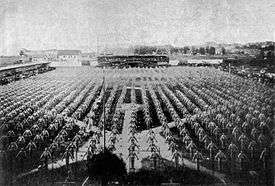
In Germany a major gymnastic movement was started by Turnvater ("father of gymnastics") Friedrich Ludwig Jahn in the early 19th century when Germany was occupied by Napoleon. The Turnvereine ("gymnastic unions"; from German turnen meaning “to practice gymnastics,” and Verein meaning “club, union”) were not only athletic, but also political, reflecting their origin in similar "nationalistic gymnastic" organizations in Europe. The Turner movement in Germany was generally liberal in nature, and many Turners took part in the Revolution of 1848.[1]

After its defeat, the movement was suppressed and many Turners left Germany, some emigrating to the United States, especially to the Ohio Valley region. Several of these Forty-Eighters went on to become Union soldiers, and some became Republican politicians.[2] Besides serving as physical education, social, political and cultural organizations for German immigrants, Turners were also active in public education and the labor movements.[3][4][5] They were leading promoters of gymnastics in the United States as a sport, and as a school subject.[6] In the United States, the movement declined after 1900, and especially after 1917.[7]
History in the United States
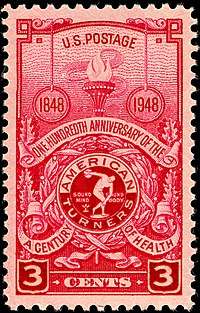
The Turnvereine made a contribution to the integration of German-Americans into their new home. The organizations continue to exist in areas of heavy German immigration, such as Iowa, Texas, Wisconsin, Indiana, Ohio, Minnesota, Missouri, Syracuse, NY, Kentucky, New York City, Sacramento , and Los Angeles.
About 1000 Turners served as Union soldiers during the Civil War. Anti-slavery was a common element, as typified by Carl Schurz. Many Republican leaders in German communities were members. However most German-Americans probably were Democrats in the 19th century. They provided the bodyguard at Abraham Lincoln's inauguration on March 4, 1861, and at his funeral in April 1865. In the Camp Jackson Affair, a large force of German volunteers helped prevent Confederate forces from seizing the government arsenal in St. Louis just prior to the beginning of the war.[8] After the Civil War the national organization took a new name, Nordamerikanischer Turnerbund" and supported German language teaching in the public high schools, as well as gymnastics. Women's auxiliaries were formed in the 1850s and 1860s. The high point in membership came in 1894, with 317 societies and about 40,000 adult male members, along with 25,000 children and 3000 women.[9]
Like other German-American groups the Turners experienced suspicion during World War I, Even though by this time they had very little contact with Germany. German Language instruction ended at many schools and universities, and the federal government imposed restrictions on German language publications. The younger generation generally demanded the switch to exclusive use of the English language in society affairs, allowing many Turner societies to continue to function.[3]
Cultural assimilation and the two World Wars with Germany took a gradual toll on membership, with some halls closing and others becoming regular dance halls, bars, or bowling alleys.[5] Fifty-four Turner societies still existed around the U.S. as of 2011. The current headquarters of the American Turners is in Louisville, Kentucky.[10]
In 1948, the U.S. Post Office issued a 3-cent commemorative stamp marking the 100th anniversary of the movement in the United States.
The Sacramento, California Turnverein, founded in 1854, claims to be the oldest still in existence in the United States.[11] The Turnverein Vorwaerts of Fort Wayne, Indiana, owned the Hugh McCulloch House from 1906 until 1966.[12]:2 It was listed on the National Register of Historic Places in 1980.[13]
Gallery
Vintage photos of the Milwaukee Turnverein
 1866
1866 1869
1869 1875
1875 1879
1879 1915
1915
Other Wisconsin Turners in 1915
 Kenosha
Kenosha Madison
Madison Madison Bears (seniors)
Madison Bears (seniors) New Holstein
New Holstein Sheboygan
Sheboygan
Jahn Monument in Berlin with memorial plaques from American Turnvereine
 Chicago, 1861
Chicago, 1861 Cincinnati, 1865
Cincinnati, 1865 Jahn Monument In Forest Park, Saint Louis MO
Jahn Monument In Forest Park, Saint Louis MO Philadelphia, 1861
Philadelphia, 1861 Washington, D.C., 1911
Washington, D.C., 1911 Davenport, Iowa Turngemeinde Monument
Davenport, Iowa Turngemeinde Monument
Turner Halls
- Turner Hall
Boonville, Missouri  Turner Hall
Turner Hall
Buffalo, Iowa Pilsen Turner Hall, Chicago, Illinois
Pilsen Turner Hall, Chicago, Illinois.jpg) Central Turner Hall (1848), Cincinnati, Ohio
Central Turner Hall (1848), Cincinnati, Ohio Germania Singing and Sport Society, Columbus, Ohio
Germania Singing and Sport Society, Columbus, Ohio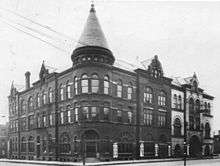 Central Turner Hall (1888), Davenport, Iowa
Central Turner Hall (1888), Davenport, Iowa- East Turner Hall (1891), Davenport, Iowa
 Northwest Turner Hall (1882), Davenport, Iowa
Northwest Turner Hall (1882), Davenport, Iowa Turner Hall
Turner Hall
Dubuque, Iowa Turner Hall (1888), Duluth, Minnesota
Turner Hall (1888), Duluth, Minnesota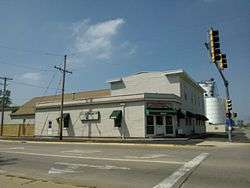
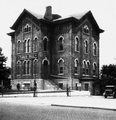 Elgin Turners
Elgin Turners
Elgin, Illinois- Turner Hall
Galena, Illinois 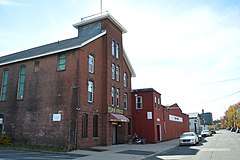 Holyoke Turner Hall
Holyoke Turner Hall
Holyoke, Massachusetts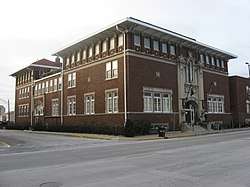 Independent Turnverein
Independent Turnverein
Indianapolis, Indiana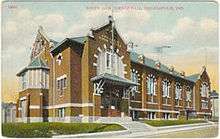 South Side Turner Hall, Indianapolis, Indiana
South Side Turner Hall, Indianapolis, Indiana_by_Rudolf_Schwarz_(1899)_Control_IAS_IN000118.jpg) Detail, South Side Turner Hall, Indianapolis, Indiana
Detail, South Side Turner Hall, Indianapolis, Indiana- Germania Turnverein, Lancaster, Pennsylvania
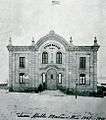 Turner Hall (1868), Madison, Wisconsin
Turner Hall (1868), Madison, Wisconsin Turner Hall (1882), Milwaukee, Wisconsin
Turner Hall (1882), Milwaukee, Wisconsin Interior ca. 1910, Turner Hall, Milwaukee, Wisconsin
Interior ca. 1910, Turner Hall, Milwaukee, Wisconsin Turners Hall (1868)
Turners Hall (1868)
New Orleans, Louisiana Turner Hall
Turner Hall
New Ulm, Minnesota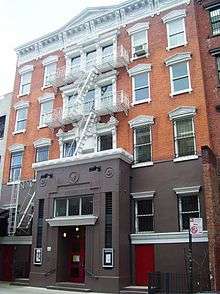 Turn-Verein, East 4th Street, New York, New York
Turn-Verein, East 4th Street, New York, New York_pg572_CENTRAL_TURN-VEREIN%2C_211_EAST_67TH_STREET.jpg) Central Turn-Verein, East 67th Street, New York, New York
Central Turn-Verein, East 67th Street, New York, New York
 Turnhalle
Turnhalle
Rock Island, Illinois
See also
| Wikimedia Commons has media related to Turner Halls. |
- German-Americans in the Civil War
- George Brosius
- Forty-Eighters
- Sokol, A comparable movement for Czechs in Europe and the United States
References
- Claire E. Nolte. "The German Turnverein". Encyclopedia of 1848 Revolutions. Retrieved January 9, 2011.
- Gruen, Mardee. "Milwaukee Turners, local Jews go back 141 years." Wisconsin Jewish Chronicle April 29, 1994; p. 6, col. 1
- Annette R. Hofmann (August 3, 1998). "150 years of Turnerism in the United States". Indiana University-Purdue University Indianapolis Max Kade Center.
- John B. Jentz. "Turnvereins". Encyclopedia of Chicago. Retrieved July 20, 2019.
- Mary Lou LeCompte. "TURNVEREIN MOVEMENT". Texas State Historical Association. Retrieved January 9, 2011.
- George Eisen; David Kenneth Wiggins (1995). Ethnicity and Sport in North American History and Culture. ABC-CLIO. p. 28.
- Annette R. Hofmann, "Transformation and Americanization: The American Turners and their new identity." International Journal of the History of Sport 19.1 (2002): 91-118.
- Scott Williams. "THE ROLE OF GERMAN IMMIGRANTS IN CIVIL WAR - MISSOURI". The Missouri Civil War Museum. Archived from the original on March 3, 2012. Retrieved January 10, 2011.
- Steven A. Reiss, ed., Sports in America from Colonial Times to the Twenty-First Century: An Encyclopedia (2011) pp 913-916.
- "Welcome to American Turners". American Turners. Archived from the original on April 6, 2011. Retrieved January 9, 2011.
- "Homepage of the Sacramento Turnverein". Retrieved June 13, 2019.
- "Indiana State Historic Architectural and Archaeological Research Database (SHAARD)" (Searchable database). Department of Natural Resources, Division of Historic Preservation and Archaeology. Retrieved July 1, 2015. Note: This includes Karen Anderson (November 1979). "National Register of Historic Places Inventory Nomination Form: Hugh McCulloch House" (PDF). Retrieved July 1, 2015. and Accompanying photographs.
- "National Register Information System". National Register of Historic Places. National Park Service. July 9, 2010.
Further reading
- Barney, Robert Knight. "German Turners in America: Their Role in Nineteenth Century Exercise Expression and Physical Education Legislation." in Earle F. Zeigler ed., American Sport and Physical Education History (to 1875) (1975): 116+. online
- Barney, Robert Knight. "Knights of Cause and Exercise: German Forty-Eighters and Turnvereine in the United States during the Antebellum Period." Canadian Journal of History of Sport 13.2 (1982): 62-79.
- Barney, Robert Knight. "America's First Turnverein: Commentary in Favor of Louisville, Kentucky." Journal of Sport History 11.1 (1984): 134-137. online
- Kramer, William M., and Norton B. Stern. "The Turnverein: A German Experience for Western Jewry." Western States Jewish History 16 (1984): 227.
- Metzner, Henry. A brief history of the American Turnerbund (1924) online>
- Pfister, Gertrud. "The Role of German Turners in American Physical Education," International Journal of the History of Sport 26 (no. 13, 2009) 1893-925
- Pumroy, Eric, and Katja Rampelmann. Research guide to the Turner movement in the United States (Greenwood, 1996).
External links
- Website of the American Turners
- Archives of the American Turners
- American Turner Topics newsletter
- Website of the Los Angeles Turners with history, photos, newsletters, and links to other Turners Organizations
- The American Turners, Wilmington Records and the Roxborough Turners Records, including by-laws, correspondence, minutes and photographs, are available for research use at the Historical Society of Pennsylvania.